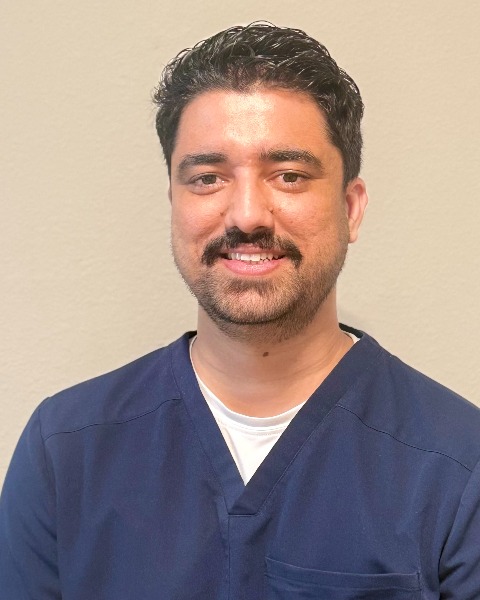Sunday Poster Session
Category: Interventional Endoscopy
P1422 - Innovative Endoscopic Therapy of Chronic Pancreatitis With Obstruction of the Afferent Limb From Prior Whipple Procedure
Sunday, October 26, 2025
3:30 PM - 7:00 PM PDT
Location: Exhibit Hall

Manish Pandey, MD (he/him/his)
Medical City Healthcare
Fort Worth, TX
Presenting Author(s)
Manish Pandey, MD, Joel Mathews, DO, Mohan Sengodan, MD, Damien Mallat, MD, Ashley Twining, PA-C, Suhail Sharif, MD
Medical City Healthcare, Fort Worth, TX
Introduction: Endoscopic Retrograde Cholangiopancreatography (ERCP) in patients with surgically altered anatomy—such as post-pancreaticoduodenectomy (Whipple procedure)—poses significant technical challenges, particularly in accessing the pancreatic duct. In cases where conventional endoscopic and percutaneous techniques fail, a multi-disciplinary intraoperative approach with endoscopy may offer a viable alternative.
Case Description/
Methods: We present a complex case of a 47-year-old male with a history of intraductal papillary mucinous neoplasm (IPMN) status post-Whipple procedure in 2010 complicated by chronic pancreatitis and pancreatic insufficiency. He presented with acute-on-chronic pancreatitis with intractable abdominal pain. Imaging revealed a 6mm obstructing pancreatic duct stone with associated ductal dilation and peripancreatic inflammation. Multiple prior endoscopic interventions—including standard and pediatric scope-assisted ERCP and EUS-guided access—had failed due to an obstructed afferent limb and tortuous anatomy. Interventional radiology was similarly unsuccessful in visualizing the pancreatic-enteric fistula. A multidisciplinary team comprising surgery and gastroenterology elected to pursue a hybrid intraoperative ERCP approach via laparotomy with identification of the afferent limb and jejunal stump, and successful formation of a gastrojejunostomy. The duodenoscope was advanced through the jejunal stump, allowing for direct deep cannulation of the pancreatic duct. Intraoperative pancreatography was performed with successful guidewire placement, followed by ductal dilation and stent placement of a 7 Fr × 5 cm plastic stent, achieving effective drainage.
Discussion: Postoperatively the patient had significant symptomatic improvement, normalization of labs, and was discharged in stable condition. Follow up ERCP two months later was performed with similar ease in accessing the pancreatic duct, confirming resolution of obstruction.This case illustrates the feasibility and effectiveness of a hybrid intraoperative ERCP via jejunal stump access in patients with complex post-Whipple anatomy. A multidisciplinary approach can offer a successful alternative to total pancreatectomy when standard endoscopic and percutaneous techniques are unsuccessful. By avoiding a total pancreatectomy and its associated long-term complications, this approach preserved pancreatic function and significantly improved the patient’s quality of life.
Disclosures:
Manish Pandey indicated no relevant financial relationships.
Joel Mathews indicated no relevant financial relationships.
Mohan Sengodan indicated no relevant financial relationships.
Damien Mallat indicated no relevant financial relationships.
Ashley Twining indicated no relevant financial relationships.
Suhail Sharif indicated no relevant financial relationships.
Manish Pandey, MD, Joel Mathews, DO, Mohan Sengodan, MD, Damien Mallat, MD, Ashley Twining, PA-C, Suhail Sharif, MD. P1422 - Innovative Endoscopic Therapy of Chronic Pancreatitis With Obstruction of the Afferent Limb From Prior Whipple Procedure, ACG 2025 Annual Scientific Meeting Abstracts. Phoenix, AZ: American College of Gastroenterology.
Medical City Healthcare, Fort Worth, TX
Introduction: Endoscopic Retrograde Cholangiopancreatography (ERCP) in patients with surgically altered anatomy—such as post-pancreaticoduodenectomy (Whipple procedure)—poses significant technical challenges, particularly in accessing the pancreatic duct. In cases where conventional endoscopic and percutaneous techniques fail, a multi-disciplinary intraoperative approach with endoscopy may offer a viable alternative.
Case Description/
Methods: We present a complex case of a 47-year-old male with a history of intraductal papillary mucinous neoplasm (IPMN) status post-Whipple procedure in 2010 complicated by chronic pancreatitis and pancreatic insufficiency. He presented with acute-on-chronic pancreatitis with intractable abdominal pain. Imaging revealed a 6mm obstructing pancreatic duct stone with associated ductal dilation and peripancreatic inflammation. Multiple prior endoscopic interventions—including standard and pediatric scope-assisted ERCP and EUS-guided access—had failed due to an obstructed afferent limb and tortuous anatomy. Interventional radiology was similarly unsuccessful in visualizing the pancreatic-enteric fistula. A multidisciplinary team comprising surgery and gastroenterology elected to pursue a hybrid intraoperative ERCP approach via laparotomy with identification of the afferent limb and jejunal stump, and successful formation of a gastrojejunostomy. The duodenoscope was advanced through the jejunal stump, allowing for direct deep cannulation of the pancreatic duct. Intraoperative pancreatography was performed with successful guidewire placement, followed by ductal dilation and stent placement of a 7 Fr × 5 cm plastic stent, achieving effective drainage.
Discussion: Postoperatively the patient had significant symptomatic improvement, normalization of labs, and was discharged in stable condition. Follow up ERCP two months later was performed with similar ease in accessing the pancreatic duct, confirming resolution of obstruction.This case illustrates the feasibility and effectiveness of a hybrid intraoperative ERCP via jejunal stump access in patients with complex post-Whipple anatomy. A multidisciplinary approach can offer a successful alternative to total pancreatectomy when standard endoscopic and percutaneous techniques are unsuccessful. By avoiding a total pancreatectomy and its associated long-term complications, this approach preserved pancreatic function and significantly improved the patient’s quality of life.
Disclosures:
Manish Pandey indicated no relevant financial relationships.
Joel Mathews indicated no relevant financial relationships.
Mohan Sengodan indicated no relevant financial relationships.
Damien Mallat indicated no relevant financial relationships.
Ashley Twining indicated no relevant financial relationships.
Suhail Sharif indicated no relevant financial relationships.
Manish Pandey, MD, Joel Mathews, DO, Mohan Sengodan, MD, Damien Mallat, MD, Ashley Twining, PA-C, Suhail Sharif, MD. P1422 - Innovative Endoscopic Therapy of Chronic Pancreatitis With Obstruction of the Afferent Limb From Prior Whipple Procedure, ACG 2025 Annual Scientific Meeting Abstracts. Phoenix, AZ: American College of Gastroenterology.
